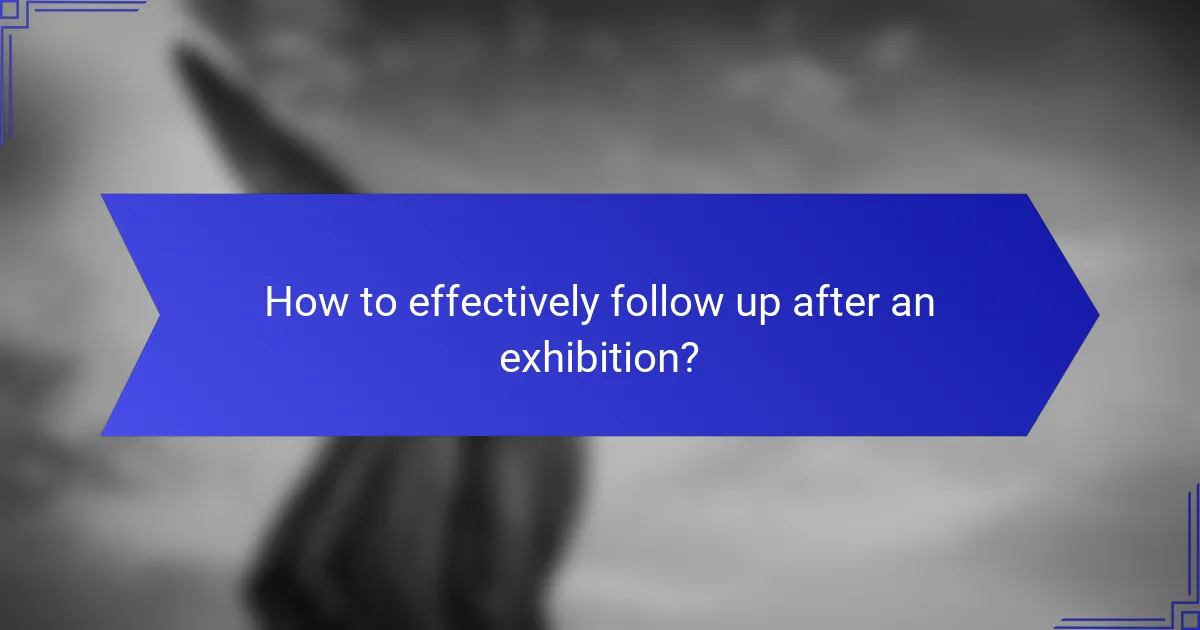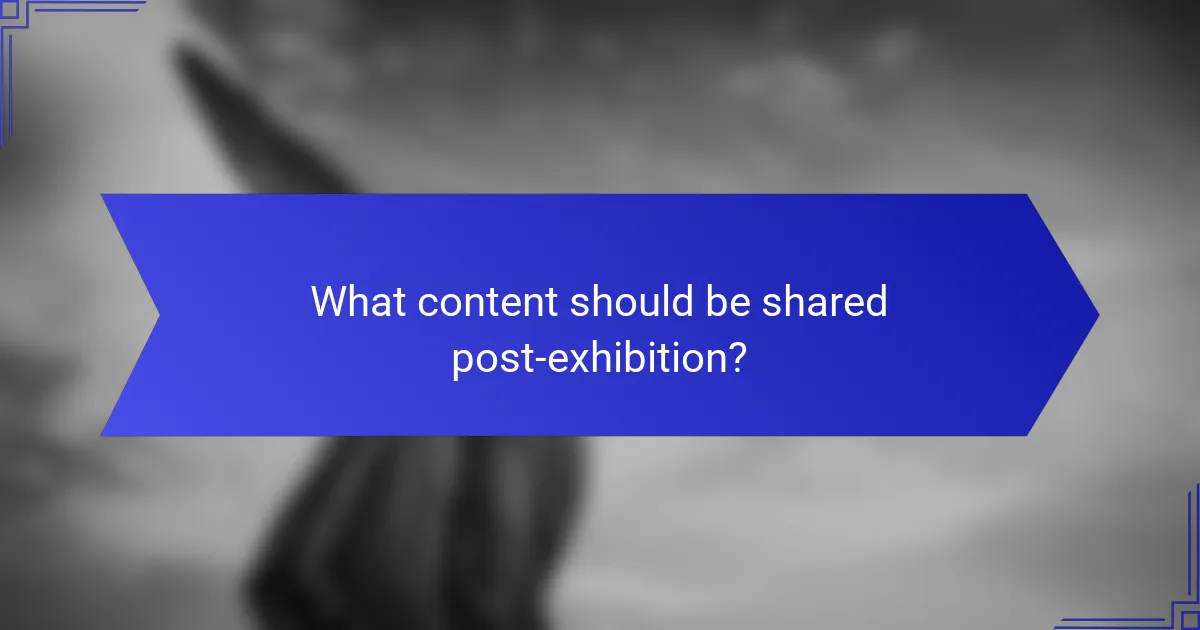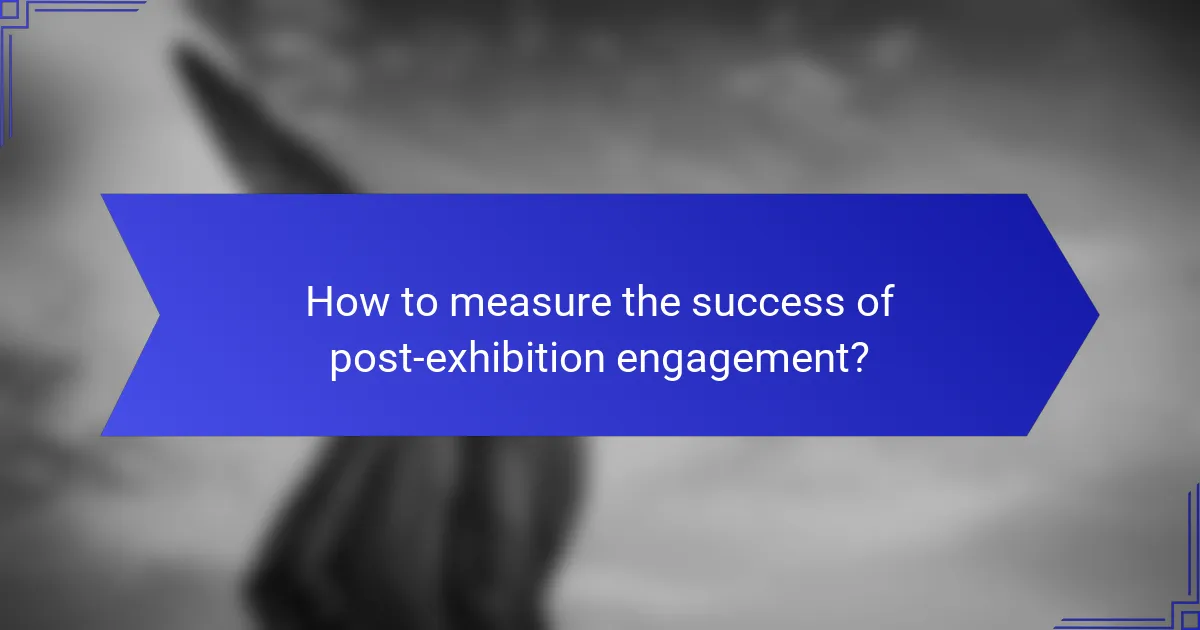Post-exhibition engagement is vital for nurturing connections and transforming leads into clients. By implementing timely follow-ups, sharing valuable content, and actively seeking feedback, organizations can enhance their relationships with attendees and improve future exhibitions.

How to effectively follow up after an exhibition?
Effective follow-up after an exhibition is crucial for maintaining connections and converting leads into clients. This involves timely communication, personalized outreach, and utilizing tools to track interactions and responses.
Email outreach strategies
Email outreach is a primary method for following up with contacts made during an exhibition. Start by crafting a concise message that references your interaction, highlights key points of interest, and includes a clear call to action. Aim to send these emails within a few days of the event to keep the conversation fresh.
Consider segmenting your email list based on the type of engagement or interest shown at the exhibition. This allows for tailored messaging that resonates more with each recipient, increasing the likelihood of a response.
Personalized communication techniques
Personalization is key to effective communication post-exhibition. Use the information gathered during the event to customize your messages, such as mentioning specific discussions or interests. This shows that you value the connection and are attentive to their needs.
Incorporate elements like personalized subject lines and targeted content that addresses the recipient’s unique challenges or goals. This approach fosters a stronger relationship and encourages further dialogue.
Timing for follow-up messages
Timing plays a critical role in the effectiveness of follow-up messages. Aim to reach out within 24 to 72 hours after the exhibition, as this is when the interaction is still fresh in the recipient’s mind. Delaying follow-up can lead to decreased interest and engagement.
Consider sending a reminder email about a week later if you haven’t received a response. This gentle nudge can reignite interest and prompt the recipient to engage with your content or offerings.
Utilizing CRM tools for tracking
CRM tools are invaluable for tracking interactions and managing follow-up processes after an exhibition. These systems can help you log contact details, categorize leads, and schedule follow-up reminders, ensuring no potential client slips through the cracks.
Choose a CRM that allows for easy integration with your email outreach and provides analytics on engagement levels. This data can inform your future strategies and help refine your approach based on what resonates most with your audience.

What content should be shared post-exhibition?
Post-exhibition content should focus on engaging your audience by sharing valuable insights, product information, and customer experiences. This helps maintain interest and encourages further interaction with your brand.
Event highlights and key takeaways
Sharing event highlights allows you to recap the most significant moments and insights from the exhibition. Focus on key presentations, discussions, and any notable interactions that occurred during the event.
Consider creating a summary document or a video montage that captures these highlights. This can serve as a valuable resource for attendees and those who couldn’t make it, reinforcing your brand’s presence and expertise.
Product demos and case studies
Product demonstrations and case studies are essential for showcasing how your offerings solve real-world problems. Share videos or detailed articles that illustrate the functionality and benefits of your products in action.
Highlight specific case studies that reflect successful implementations, including metrics that demonstrate effectiveness. This not only informs potential customers but also builds credibility and trust in your solutions.
Customer testimonials and feedback
Customer testimonials and feedback provide social proof and can significantly influence potential buyers. Collect and share positive reviews from exhibition attendees who interacted with your products or services.
Consider creating a dedicated section on your website or social media channels for these testimonials. Use quotes, video snippets, or even case studies to illustrate how your products have made a difference for your customers.

How to gather feedback from exhibition attendees?
Gathering feedback from exhibition attendees is essential for understanding their experiences and improving future events. Effective methods include surveys, in-person feedback sessions, and leveraging social media to capture insights.
Surveys and questionnaires
Surveys and questionnaires are a straightforward way to collect structured feedback from attendees. They can be distributed digitally via email or through event apps, allowing for quick responses and easy data analysis.
Consider using a mix of multiple-choice questions and open-ended responses to gather both quantitative and qualitative insights. Aim for a completion time of under five minutes to encourage participation.
To increase response rates, offer incentives such as discounts on future events or entry into a prize draw.
In-person feedback sessions
In-person feedback sessions provide an opportunity for deeper engagement with attendees. These can be organized as informal discussions or structured focus groups, allowing participants to share their thoughts in a comfortable setting.
Schedule these sessions shortly after the exhibition to capture fresh impressions. Keep the group size manageable, ideally between five to ten attendees, to facilitate open dialogue.
Be sure to take notes or record the sessions (with consent) for thorough analysis later.
Utilizing social media for insights
Social media platforms are valuable tools for gathering real-time feedback from exhibition attendees. Encourage attendees to share their experiences using a specific event hashtag, which can help you track conversations and sentiments.
Monitor platforms like Twitter, Instagram, and Facebook for mentions and comments related to your event. Engaging with attendees online can also foster a sense of community and encourage more feedback.
Consider running polls or asking specific questions on your social media channels to gather targeted insights quickly.

What are the best practices for content sharing?
Effective content sharing involves selecting the right platforms, creating engaging visuals, and timing your posts strategically. These practices enhance visibility and engagement, ensuring your audience connects with your exhibition content.
Choosing the right platforms
Selecting the appropriate platforms for sharing content is crucial for reaching your target audience. Consider where your audience is most active; platforms like Instagram and LinkedIn cater to different demographics and content types.
For visual-heavy content, Instagram and Pinterest are ideal, while LinkedIn is better for professional insights and B2B engagement. Tailor your content to fit the platform’s strengths for maximum impact.
Creating engaging visual content
Visual content should be eye-catching and relevant to your exhibition. Use high-quality images, infographics, and videos to convey your message effectively. Tools like Canva or Adobe Spark can help you create professional-looking visuals without extensive design skills.
Incorporate branding elements such as logos and color schemes to maintain consistency. Engaging visuals can significantly increase shares and interactions, making your content more memorable.
Timing and frequency of posts
Timing and frequency are key to maximizing engagement with your content. Research suggests that posting during peak hours—typically mid-morning and early evening—can lead to higher visibility. Experiment with different times to find what works best for your audience.
As for frequency, aim for a balanced approach; posting too often can overwhelm your audience, while infrequent posts may lead to disengagement. A good rule of thumb is to share content several times a week, adjusting based on audience response and platform norms.

How to measure the success of post-exhibition engagement?
Measuring the success of post-exhibition engagement involves evaluating various metrics that reflect how well your follow-up strategies resonate with attendees. Key indicators include response rates, content shares, and feedback quality, which provide insights into the effectiveness of your engagement efforts.
Key performance indicators (KPIs)
Key performance indicators (KPIs) are essential for assessing the impact of your post-exhibition engagement. Common KPIs include the number of follow-up emails opened, click-through rates on shared content, and the volume of feedback received. These metrics help you gauge attendee interest and engagement levels.
Consider tracking social media interactions as well, such as shares, likes, and comments on posts related to the exhibition. This can provide a broader view of how your content is being received and discussed in the community. Aim for a response rate of around 20-30% for follow-up emails to ensure effective communication.
Additionally, using surveys to collect qualitative feedback can enhance your understanding of attendee experiences. Focus on specific questions regarding their interests and suggestions for improvement, which can guide future exhibitions and engagement strategies.
